
Champlevé
Champlevé is a traditional decorative technique used in jewelry making where the artist carves or etches out areas in metal and fills them with colored enamel. Think of it like creating little pools in metal and filling them with colored glass that's then heated until it melts smooth. This method is often used to create detailed, colorful designs in jewelry pieces. When you see this term on a resume, it shows that the candidate knows how to work with both metal carving and enameling, which are valuable skills in fine jewelry making. Similar techniques include cloisonné and plique-à-jour, but champlevé is specifically about creating recessed areas in the metal itself.
Examples in Resumes
Created a collection of bronze pendants using Champlevé enameling technique
Taught Champlevé and basic enameling workshops at local art center
Specialized in fine metal jewelry incorporating Champlevé and Champlevé Enamel techniques
Typical job title: "Enamel Artists"
Also try searching for:
Where to Find Enamel Artists
Professional Organizations
Online Communities
Job Resources
Example Interview Questions
Senior Level Questions
Q: Can you describe your experience training others in champlevé techniques?
Expected Answer: A senior artist should be able to discuss their teaching methods, safety protocols, and how they help others troubleshoot common issues in champlevé enameling.
Q: How do you handle complex custom champlevé projects from concept to completion?
Expected Answer: They should explain their process of working with clients, creating designs, selecting appropriate metals and enamels, and managing project timelines.
Mid Level Questions
Q: What methods do you use to ensure consistent enamel color and quality?
Expected Answer: Should discuss temperature control, metal preparation, and techniques for achieving even application and proper firing of enamels.
Q: How do you handle repairs on champlevé pieces?
Expected Answer: Should be able to explain the process of evaluating damage, removing old enamel if necessary, and properly refinishing pieces while maintaining the original design.
Junior Level Questions
Q: What safety precautions do you take when working with enamels?
Expected Answer: Should mention proper ventilation, protective equipment, and safe handling of materials and hot kilns.
Q: Can you describe the basic steps of the champlevé process?
Expected Answer: Should be able to explain metal preparation, carving or etching, enamel application, and firing basics.
Experience Level Indicators
Junior (0-2 years)
- Basic metal preparation
- Simple enamel application
- Understanding of firing temperatures
- Basic tool handling and safety
Mid (2-5 years)
- Complex design creation
- Color mixing and matching
- Multiple firing techniques
- Basic repairs and problem-solving
Senior (5+ years)
- Advanced design and execution
- Teaching and mentoring
- Complex repairs
- Custom work and client management
Red Flags to Watch For
- No knowledge of basic enameling safety procedures
- Lack of experience with proper tool handling
- Unable to explain basic metal preparation steps
- No understanding of firing temperatures and timing
Related Terms
Need more hiring wisdom? Check these out...

The Hidden Art of Salary Negotiation: How to Win Hearts Without Going Broke

Refining Job Descriptions to Expand Applicant Pools: Casting a Wider Talent Net

Breaking the Mold: The Unseen Power of Building a Diverse Leadership Team

